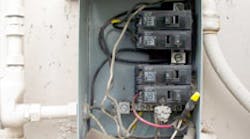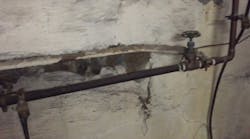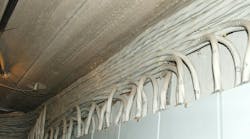As usual, never consider the following commentary associated with these photos as a formal interpretation of the National Electrical Code (NEC). Without criticizing anyone or any product, the following scenarios present us with serious safety questions.
All references are based on the 2008 NEC.
A VIOLATION WITH SOME STING
Gary Parker, P.E., Burns & McDonnell, Centennial, Colo., found a circuit breaker panel installation that's gone through a few changes that do not comply with the NEC. “The installation was found on the exterior of a water storage tank,” says Parker. “If there ever was an interior cover in this panel, it was not found. It was probably lost when the cord and receptacle were added. The circuits supplied 120V power to the tank cathodic protection rectifier and level transmitter. When you look closely at the bottom of the panel, you can see the terminal bar with grounded (neutral) and equipment-grounding conductors connected together. I am sure the wasps enjoyed their home on top of the circuit breaker. This installation was removed and replaced with all new Code-compliant equipment and wiring methods.”
Cord connections of this type, located in an enclosure, are not permitted but may be considered as noted in the Fine Print Note (FPN) of 400.10 (Pull at Joints and Terminals). The FPN states, “Some methods of preventing pull on a cord from being transmitted to joints or terminals are knotting the cord, winding with tape, and fittings designed for the purpose.”
In addition, connection of the grounded (neutral) conductor and equipment-grounding conductor in this enclosure violates 408.40 (Grounding of Panelboards).
NON-MOVING VIOLATION
Marc VanOstrand, an electrician with Star Electric in Roanoke, Va., recently ran across this ridiculous installation. “This is what you do if it costs too much to move it,” says VanOstrand.
No rule would recognize the installation of the service drop passing through the house! As noted in 230.3 (One Building or Other Structure Not to Be Supplied Through Another), “Service conductors supplying a building or other structure shall not pass through the interior of another building or structure.”
This service drop is also required to be installed so as to comply with 230.24(B) [Vertical Clearance for Service-Drop Conductors].
Found a Code Violation? E-mail your photos (no cell phone images, please) to Joe Tedesco at [email protected]





